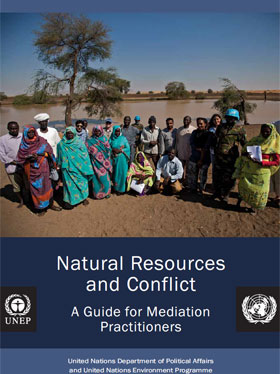Natural Resources and Conflict: A Guide for Mediation Practitioners
Mediating Natural Resource Conflicts is a collaborative research project undertaken by the Policy and Mediation Division of the United Nations Department of Political Affairs (DPA/PMD) and the Environmental Cooperation for Peacebuilding initiative of the United Nations Environment Programme (UNEP).
The project has also received support from Columbia University’s Center for International Conflict Resolution (CICR), the Centre for Humanitarian Dialogue (HD), and the EU-UN Partnership on Land, Natural Resources and Conflict Prevention.
This guide collects and summarizes good practices on the successful mediation of resource conflicts. It draws on the field experiences of mediators and mediation experts, specifically those with natural resource expertise. It also features lessons learned from UNEP’s work on environmental diplomacy in different conflict-affected countries, with a particular focus on how to use impartial technical knowledge to equalize stakeholder information in a mediation process.
This foundational knowledge was supplemented with the experience and insights of over thirty mediators who participated in an expert meeting in New York to share their own good practices and lessons learned on mediating natural resource conflicts. The workshop provided an invaluable opportunity to develop and refine the ideas in this guide, and the development team is grateful for the active and generous engagement of all participants.
The guide was also subject to external peer review, which greatly enhanced the quality and clarity of the content. This guide also builds on the conflict prevention research undertaken by the aforementioned EU-UN Partnership as well as on the case studies and innovative practices identified within the global Knowledge Platform on Environmental Peacebuilding.
The primary audience for this guide is mediation professionals and supporting institutions involved in localized or transboundary natural resource disputes, or those engaged in peace processes where natural resources play a critical role. However, it may also be of interest to stakeholders and natural resource management experts involved in disputes over natural resources that might be considering a mediated solution, ranging from governments and companies to local communities and nongovernmental organizations. It also contains information that is relevant to experts working on conflict-sensitivity, conflict prevention, and peacebuilding linked to extractive resources, land, and water.
This guide is being published in two formats. A compact version containing only the core guidance (Part A) and short practical examples that can be used by mediators as a reference for structuring mediation processes, sharing the methodology with key stakeholders, and delivering training. In addition, a longer version of the guide includes the core guidance plus nine detailed case studies (Part B) that demonstrate how different strategies and good practices have been combined in mediation processes. This longer version also contains a list of resources for additional reading. Together, these case studies and reference materials provide a range of successful approaches that mediators and stakeholders can draw ideas and inspiration from to inform on-going deliberations.
This guide was made possible through the generous contributions of the governments of Finland and Italy, as well as the support of the European Union.











